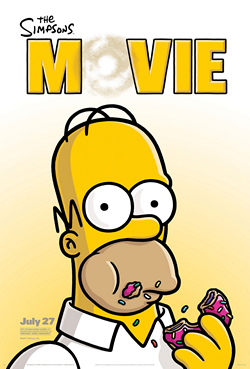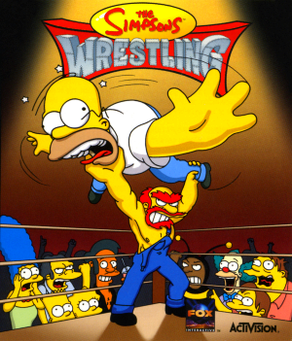
Margaret "Maggie" Simpson is a fictional character in the animated television series The Simpsons and the youngest member of the Simpson family. She first appeared on television in the Tracey Ullman Show short "Good Night" on April 19, 1987. Maggie was created and designed by cartoonist Matt Groening while he was waiting in the lobby of James L. Brooks' office. She received her first name from Groening's youngest sister. After appearing on The Tracey Ullman Show for three years, the Simpson family was given their own series on the Fox Broadcasting Company which debuted December 17, 1989.

Abraham Jebediah "Abe" Simpson II, better known as Grampa Simpson, is a recurring character in the animated television series The Simpsons. He made his first appearance in the episode entitled "Grandpa and the Kids", a one-minute Simpsons short on The Tracey Ullman Show, before the debut of the television show in 1989.
Apu Nahasapeemapetilon is a recurring character in the American animated television series The Simpsons. He is an Indian immigrant proprietor who runs the Kwik-E-Mart, a popular convenience store in Springfield, and is known for his catchphrase, "Thank you, come again". He was voiced by Hank Azaria and first appeared in the episode "The Telltale Head". He was named in honor of the title character of The Apu Trilogy by Satyajit Ray.

Reverend Timothy "Tim" Lovejoy, Jr. is a recurring character in the animated television series The Simpsons. He is voiced by Harry Shearer, and first appeared in the episode "The Telltale Head".

Robert Underdunk Terwilliger Jr., PhD, better known as Sideshow Bob, is a recurring character in the animated television series The Simpsons. He is voiced by Kelsey Grammer and first appeared in the episode "The Telltale Head". Bob is a self-proclaimed genius who is a graduate of Yale University and a champion of high culture, including the adoption of a transatlantic accent, similar to that of Grammer's portrayal of Dr. Frasier Crane from the sitcoms Cheers and Frasier. He began his career as a sidekick on Krusty the Clown's television show, but after enduring constant abuse, Bob framed his employer for armed robbery in "Krusty Gets Busted", only to be foiled by Bart Simpson, and sent to prison. Bob started seeking revenge against Bart while in prison, and the two became feuding arch-enemies.

Springfield is the primary fictional setting of the American animated sitcom The Simpsons and related media. It is an average-sized, fictional city within an unknown state in the United States. The fictional city's geography, surroundings, and layout are flexible, often changing to accommodate the plot of any given episode.

The Simpsons: Hit & Run is a 2003 action-adventure game developed by Radical Entertainment and published by Vivendi Universal Games. It is based on the American animated sitcom The Simpsons, and is the twenty-second installment in the Simpsons series of video games.

The Simpsons Movie is a 2007 American animated comedy film based on the Fox animated sitcom the The Simpsons by Matt Groening. The film was directed by the show's supervising producer David Silverman and stars the show's regular cast of Dan Castellaneta, Julie Kavner, Nancy Cartwright, Yeardley Smith, Hank Azaria, Harry Shearer, Pamela Hayden, and Tress MacNeille reprising their roles and Albert Brooks as the film's main antagonist, Russ Cargill, head of the EPA. The film follows Homer Simpson, who irresponsibly pollutes the lake in Springfield, causing the Environmental Protection Agency (EPA) to imprison the town under a giant glass dome. After he and his family escape to Alaska, they ultimately abandon Homer for his selfishness and return to Springfield to prevent the town's demolition by Cargill. Homer works to redeem his folly by returning to Springfield himself in an effort to save it.

"HOMR" is the ninth episode of the twelfth season of the American animated television series The Simpsons. The 257th episode overall, it originally aired on the Fox network in the United States on January 7, 2001. In the episode, while working as a human guinea pig, Homer discovers the root cause of his subnormal intelligence: a crayon that was lodged in his brain ever since he was six years old. He decides to have it removed to increase his IQ, but soon learns that being intelligent is not always the same as being happy.

"Saddlesore Galactica" is the thirteenth episode of the eleventh season of the American animated television series The Simpsons. It originally aired on the Fox network in the United States on February 6, 2000. In the episode, the Simpson family rescues a diving horse named Duncan from an abusive owner and keeps him as a pet. When the cost of keeping Duncan rises, Homer and Bart train him to be a racehorse. Duncan wins several races and, as a result, Homer is threatened with death by a group of jockeys. Meanwhile, Lisa is upset over her school unfairly losing the musical band competition at a state fair and writes a letter to U.S. President Bill Clinton in protest.

The Simpsons: Cartoon Studio is a computer program based on the animated television series The Simpsons that was released for PC and Mac computers in 1996 by Fox Interactive. It allows users to create their own Simpsons cartoons, using characters, sounds, music, and locations from the show. The cast members of The Simpsons provided their voices for the program. The Simpsons Cartoon Studio has received generally positive reviews, although there has been some criticism too.

The Simpsons Wrestling is a sports video game based on the animated television series The Simpsons for the PlayStation. Developed by Big Ape Productions and published by Fox Interactive through a co-publishing agreement with Electronic Arts in Europe and Activision in North America, the game was first released in Europe in March 2001, followed by North America a month later. It is the only Simpsons video game released for the PlayStation.
"Radioactive Man" is the second episode of the seventh season of the American animated television series The Simpsons. It originally aired on the Fox network in the United States on September 24, 1995. In the episode, the film version of the comic book series Radioactive Man is shot in Springfield. Much to Bart's disappointment, the part of the hero's sidekick, Fallout Boy, goes to Milhouse. When he tires of the long hours required to shoot the film, Milhouse quits the role, forcing the filmmakers to cease production and return to Hollywood.

"Homer and Apu" is the thirteenth episode of the fifth season of the American animated television series The Simpsons. It originally aired on the Fox network in the United States on February 10, 1994. In the episode, Homer participates in a hidden-camera investigation of spoiled food being sold at the Kwik-E-Mart. The chain's corporate office fires Apu and replaces him with actor James Woods, who is doing research for an upcoming film role. Apu misses his job, so he and Homer travel to India to persuade the head of the Kwik-E-Mart corporation to rehire him.
The World of Springfield is a series of action figures featuring characters from the animated sitcom The Simpsons. The line ran between December 1999 and December 2004 and was released by Playmates Toys.

The Simpsons is an American animated comedy franchise whose eponymous family consists of Homer, Marge, Bart, Lisa, and Maggie. The Simpsons were created by cartoonist Matt Groening for a series of animated shorts that debuted on The Tracey Ullman Show on Fox on April 19, 1987. After a three-season run, the sketch was developed into The Simpsons, a half-hour prime time show that was an early hit for Fox, becoming the first Fox series to land in the Top 30 ratings in a season (1989–1990). The popularity of The Simpsons has made it a billion-dollar merchandising and media franchise. Alongside the television series, the characters of the show have been featured in a variety of media, including books, comic books, a magazine, musical releases, and video games.
"Exit Through the Kwik-E-Mart" is the fifteenth episode of the twenty-third season of the American animated television series The Simpsons, and the 501st episode overall. It originally aired on the Fox network in the United States on March 4, 2012. In the episode, Bart is punished by Homer after letting a rabbit loose in the house. He gets revenge on his father by spray-painting images of him with the word "dope" all over Springfield. Street artist Shepard Fairey encounters Bart one night and offers him a gallery show of Bart's artworks. However, Chief Wiggum suddenly appears during the show and arrests Bart for covering the town in graffiti. It turns out that Fairey is an undercover officer working for Wiggum.

The Simpsons: Tapped Out (TSTO), or simply known as Tapped Out, is a freemium licensed city-building mobile game for iOS and Android, based on the American animated comedy television series The Simpsons. It allows users to create and maintain their own version of Springfield using familiar characters and buildings. The game is regularly updated with new content, often seasonal and holiday-themed, for example, during holidays like Thanksgiving, and Treehouse of Horror episodes-related content for Halloween. The game is available in several languages such as English, French, Turkish, Italian, German, Simplified Chinese, Peninsular Spanish and both European Portuguese and Brazilian Portuguese. The game was developed and published by EA Mobile and launched in Europe on February 29, 2012 and in North America on March 1, 2012 for iOS and February 6, 2013 for Android. The game was released for Amazon Fire devices in several markets on June 24, 2013.

Anastasia: Adventures with Pooka and Bartok is a puzzle video game based on the 1997 animated film Anastasia. Developed by Motion Works, published by Fox Interactive and distributed by 20th Century Fox Home Entertainment, the title was released on November 25, 1997. It was produced by David Wisehart, who also served as voiceover director. The game had an estimated budget of US$800,000.

Springfield is a chain of themed areas at Universal theme parks in Florida and Hollywood, based on the town of the same name from the long-hit American television animated sitcom, The Simpsons.

















